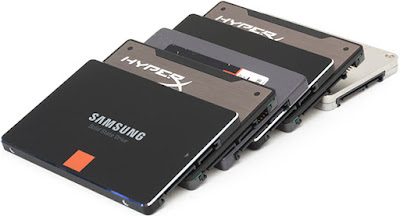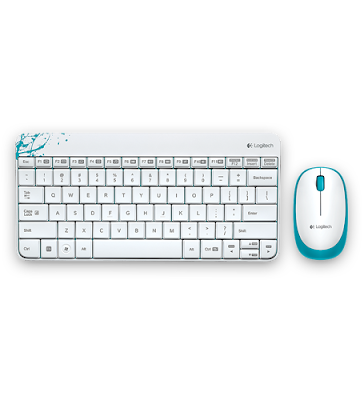 |
| SSDs, compared to HDDs, are smaller and more compact |
Anda berbahasa Indonesia? Baca artikel terjemahan di
sini!
Have you ever heard of SSDs? If not, that’s fine. Actually, SSDs are like HDDs or most commonly known as harddisks, or storage. Except, there’s one obvious difference: HDDs spin while SSDs don’t. The term “SSD” is an acronym for “Solid State Disk”. The word “solid” is taken from the fact that they don’t spin. In fact, they look exactly like memory chips (or RAM, according to some people).
A HDD’s speed is determined by how many spins it can make per minute. For example, the standard modern HDD is rated at 5400rpm while the speedier ones can score 7200rpm. HDD seeks data by reading “blocks” which are embedded on the spinning part. Ever saw a gramophone? Yes, that’s exactly how HDDs get your data, which is why spinning speed matters. The faster the disk spins, the faster it fetches your data. On the other hand, SSDs don’t spin. Your data is stored on the chips and is available for access at any time. However, unlike RAM, which clears out its storage when it runs out of power, SSDs retain their stored data even when they’re off. Think of it as a flash drive, but faster.
 |
| What's inside SSDs |
Because SSDs utilize flash memory chips, they are fast, dead fast, much faster than your traditional HDDs. However, they’re very, very expensive. For example, for the price of Rp1,155,000.00 (that’s roughly U$85~90), you only get 250GB SSD, while for that price, you ought to get at least a 1 or 2TB HDD. Fortunately, they’re now cheaper than ever compared to a few years ago. That’s why I decided to try them out a few days ago. There used to be a reliability issues, but the latest data I read was that in order to spend the entire lifespan of a drive, you got to write at least ~200GB of data per day. Except you’re running a server which constantly transfers files, you shouldn’t worry about this. Chances are, you’d already get a new laptop before the SSD fails.
The Subject: Dell Inspiron 5447
I have an almost 2-year-old Dell Inspiron laptop. It’s a machine that accompanied me through the end half of my college. It even helped me finish my thesis. It’s still quite powerful: i7-4210U, 8GB RAM, 1TB storage, along with a discrete GPU (Radeon R5 M265X). While 8GB of RAM is still enough, I sometimes still get sluggish performance. At that time, I know I have enough money to spend on a SSD and I decided to get one (while at the same time I also wanted to reset my laptop–too much junk).
The SSD
 |
| Samsung's 850 EVO SSD Box |
So, here’s what I got: a Samsung 850 EVO SSD 250GB for Rp1,155,000.00 (U$85~90). Some of you might ask “Why so low?” and let me answer you: besides economical reasons, I was also confident that I didn’t need to store that much amount of files. I have a PC at home and a 2TB external HDD. That’s more than enough to store my files. Anyway, I got my laptop’s HDD replaced at a Dell Store in Hi-Tech Mall (seriously, that’s the real name of a mall which specifically sells stuffs related to computers in Surabaya, Indonesia).
The staff was very friendly, and he even offered me a free recovery DVD. Yeah, that had to happen since he had no way to clone the disk. Without that recovery DVD, I would need to pray that the Windows 10 installer would recognize the key embedded in the laptop. At that time, I didn’t know if 2.5” disk enclosures exist and are compatible with SSDs. If I had known, I would’ve asked the staff to clone the HDD beforehand.
The Process
 |
| The SSD itself. Very small and light. |
At least the process was simple… Very simple. However, I just don’t have the guts to do it myself. Why, because it involves quite a large sum of money… and honestly, I’m too afraid to break it. Anyway, the staff merely had to take off the access panel (the plastic layer that is between you and your laptop’s internals). Once it’s off, it’s easy to identify where your HDD is. Just take your HDD off by unscrewing the brackets, then take the HDD off. Afterwards, just put the SSD into the bracket, then screw it back into your laptop. Don’t forget the connector, though. Don’t be afraid to plug it the wrong way, the magic of computer connectors is that you won’t be able to plug it the wrong way. Just don’t force it if it doesn’t want to go in.
 |
| The SSD is now sitting nicely in my laptop |
Anyway, the next process is migrating the data. Unfortunately, this was done in the wrong order. Before replacing the HDD with the SSD, I should’ve purchased a 2.5” HDD enclosure, put the SSD into it, then cloned the drive. However, the staff replaced the SSD first, then when he was restoring a factory image into my laptop, I went out to buy the disk enclosure. Fortunately, the recovery process went smoothly, although I lost all my data (don’t worry, I had prepared for this, although wouldn’t have happened if the HDD had been cloned to the SSD) and was forced to get back to Windows 8, which refused to get activated. How so? Well, I had upgraded to Windows 10, so whatever the key embedded in my laptop’s motherboard was registered for Windows 10. It won’t activate Windows 8. Fortunately, I managed to upgrade back to Windows 10 by selecting “I am reinstalling Windows 10” when the installer asked for a key. Windows 10 automatically detected the key, and I’m running the latest Windows 10 build right now.
Here’s how the process should’ve been:
- Get an SSD and a compatible 2.5” disk enclosure (if your laptop doesn’t have an additional HDD bay available).
- Put the SSD into the enclosure, and connect it into your computer.
- Once it’s detected, use a disk cloning software (such as EaseUs Partition Master or MiniTool Partition Wizard) to clone your HDD to your SSD.
- Replace the HDD with SSD and see if it’s detected by your BIOS. Just in case, check the boot order. Make sure your system is booted from the SSD.
- You’re done. There shouldn’t be any problem now.
Oh yeah, and don’t forget installing the SSD utility from the manufacturer (if available) such as Disk Magician for Samsung’s SSDs. That utility should be able to monitor and optimize your drive. It’s very useful, you should install it.
 |
| All SSDs should come with their own proprietary utilitysoftware. It's very useful. |
But what would happen to my old hard drive? Should I toss it out? Heck, unless it's choked full of bad sectors, I don't think you should do that. The wisest thing to do is to re-use that old drive. Either put it into one of your PCs or put it into a 2.5" enclosure and turn it into an external HDD, which I did.
 |
| Now I can use my old HDD as my portable storage :p |
The Result
Oh God, seriously, after upgrading (or downgrading, capacity-wise…) to SSD, things just fly. Boot time has become much faster (from tens of seconds to merely a few), besides significantly reduced app install and opening times. To make things more… evident and scientific, I decided to run a benchmark. By using Crystal Disk Mark, I run a benchmark on the newly-installed SSD, along with my old HDD (now seated in an enclosure) and my PC’s internal HDD. The third one acts as a placeholder, since USB3.0 in real life isn’t as fast as SATA3, which might give an inconsistency in the results. So, here are the results. Please don’t mind the theme, I like anime.
 |
| Benchmark from the SSD. Overwhelming. |
 |
| Benchmark from my laptop's ex-internal-storage (A Seagate, but I
can't remember which series) |
 |
| Benchmark from my PC's internal storage, a WD Blue.
Very underwhelming... |
From those screenshots, you can see the SSD crushes both HDDs, no matter which connector they use (USB3.0 or SATA). That’s the reason why your overall performance flies. Since CPU actually doesn’t do much in everyday tasks (except if you’re a pro designer who does a lot of rendering and exporting graphics and videos), even older laptops (as old as Core2Duo) will feel like new if you give them SSDs. Why, because opening files and apps, saving them, involves HDD much more (reading and writing data) than CPU.
The Conclusion
To be honest, I don’t understand that deep about how SSDs work. All I know is that they’re fast, quite reliable (at least modern SSDs are), and expensive. This article is to share to you guys my experience when upgrading to SSD. So, here are my conclusions:
Pros:
- Significant boost in performance
- Much quieter and cooler than traditional HDDs
- Don’t worry when traveling with your laptop asleep
Cons:
- Significantly more expensive with less capacity
- Possible doubts around SSDs’ reliability
My advice? If you want to upgrade, go for the big brand such as Samsung, Kingston, Corsair, or Intel. There are indeed cheaper SSDs available, but I honestly can’t comment about their reliability. I chose Samsung because of their whopping 5-year warranty (10 years for the Pro line). Additionally, rather than buying an expensive new notebook, you might want to consider to give your notebook a new life by upgrading them to SSDs. Not the ones that are too old, though… you be the judge.
If you’re looking for an alternative, there are also hybrid drives out there that are called "Solid State Hard Drive" (SSHD), which uses small SSDs for only caching purposes, thus improving HDD performance. These drives are usually marketed as performance-oriented such as WD Black and they, of course, are more expensive. Well, at least you get the best of both worlds.
 |
| A WD Black Solid State Hard Drive |
Well, I guess that’s all, Folks. I apologize that I don’t have enough technical skills to explain further about SSDs. However, I know that they are very useful and bring significant improvement in performance, and in the coming years, I am confident that they are going to replace HDDs. For now, however, HDDs still take the crown for their affordable price and higher capacity. Anyway, thanks for reading and I’m looking forward to your next visit. Have a nice day! :D












Forbes bahasa Indonesia -> Majalah Forbes
ReplyDeleteBerita Indonesia -> Ina News
Yang lagi Viral -> Liputan Viral
Berita lagi ganss -> Rekan Bola
Berita dan ilmu Bitcoin -> Blog Fastcoin99
Jual Cepat Bitcoin mu di-> Fastcoin99